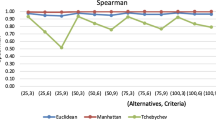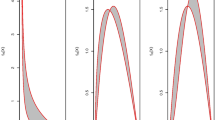Abstract
This paper proposes an efficient interval moment method (IMM) for uncertainty propagation analysis with non-parameterized probability-box (p-box), where the bounds of statistical moments and cumulative distribution function (CDF) of output response can be simultaneously obtained. Firstly, two output response bounds are defined based on the equivalent probability transformation, which converts the original imprecise uncertainty propagation problem into two precise uncertainty propagation problems. Then, sparse grid numerical integration (SGNI) is employed to estimate the statistical moments of output response bounds. To improve computational efficiency, a multi-interval efficient global optimization (MI-EGO) algorithm is developed to capture the minimum and maximum responses on all collocation intervals of SGNI. By reconstructing the distributions of output response bounds using the maximum entropy method, the CDF bounds of output response can be acquired accordingly. Furthermore, by reusing the previous functional evaluations in the interval multiplication, the bounds of the statistical moments of output response can be estimated by SGNI again. Three numerical examples are investigated to verify the accuracy and efficiency of the proposed method.







Similar content being viewed by others
References
Hu, C., Youn, B.D., Wang, P.: Engineering Design Under Uncertainty and Health Prognostics. Springer, Cham (2019)
Zhao, Y.G., Lu, Z.H.: Structural Reliability: Approaches from Perspectives of Statistical moments. Wiley, Hoboken (2021)
Ghanem, R.G., Spanos, P.D.: Stochastic Finite Elements: A Spectral Approach. Dover Publications, INC (2003)
Beer, M., Ferson, S., Kreinovich, V.: Imprecise probabilities in engineering analyses. Mech. Syst. Signal. Process. 37(1–2), 4–29 (2013)
Yang, X.F., Liu, Y.S., Zhang, Y.S., Yue, Z.F.: Hybrid reliability analysis with both random and probability-box variables. Acta. Mech. 226, 1341–1357 (2015)
Wang, C., Zhang, H., Beer, M.: Computing tight bounds of structural reliability under imprecise probabilistic information. Comput. Struct. 208, 92–104 (2018)
Jiang, C., Zheng, J., Han, X.: Probability-interval hybrid uncertainty analysis for structures with both aleatory and epistemic uncertainties: a review. Struct. Multidiscip. Optim. 57(6), 2485–2502 (2018)
Faes, M., Daub, M., Marelli, S., Patelli, E., Beer, M.: Engineering analysis with probability boxes: a review on computational methods. Struct. Saf. 93, 102092 (2021)
Dubois, D., Prade, H.: Random sets and fuzzy interval analysis. Fuzzy Sets Syst. 42(1), 87–101 (1991)
Alvarez, D.A., Uribe, F., Hurtado, J.E.: Estimation of the lower and upper bounds on the probability of failure using subset simulation and random set theory. Mech. Syst. Signal Process. 100, 782–801 (2018)
Cao, L., Liu, J., Jiang, C., Wu, Z., Zhang, Z.: Evidence-based structural uncertainty quantification by dimension reduction decomposition and marginal interval analysis. J. Mech. Des. 142(5), 051701 (2020)
Zhang, Z., Jiang, C.: Evidence-theory-based structural reliability analysis with epistemic uncertainty: a review. Struct. Multidiscip. Optim. 63, 2935–2953 (2021)
Möller, B., Beer, M.: Fuzzy Randomness: Uncertainty in Civil Engineering and Computational Mechanics. Springer, Berlin (2004)
Ghosh, D.D., Olewnik, A.: Computationally efficient imprecise uncertainty propagation. J. Mech. Des. 135(5), 051002 (2013)
Xiong, F., Greene, S., Chen, W., Xiong, Y., Yang, S.: A new sparse grid based method for uncertainty propagation. Struct. Multidiscip. Optim. 41(3), 335–349 (2010)
He, J., Gao, S., Gong, J.: A sparse grid stochastic collocation method for structural reliability analysis. Struct. Saf. 51, 29–34 (2014)
Xiao, Z., Han, X., Jiang, C., Yang, G.: An efficient uncertainty propagation method for parameterized probability boxes. Acta Mech. 227(3), 633–649 (2016)
Liu, H.B., Jiang, C., Jia, X.Y., Long, X.Y., Zhang, Z., Guan, F.J.: A new uncertainty propagation method for problems with parameterized probability-boxes. Reliab. Eng. Syst. Saf. 172, 64–73 (2018)
Liu, H.B., Jiang, C., Liu, J., Mao, J.Z.: Uncertainty propagation analysis using sparse grid technique and saddlepoint approximation based on parameterized p-box representation. Struct. Multidiscip. Optim. 59(1), 61–74 (2019)
Liu, H.B., Jiang, C., Xiao, Z.: Efficient uncertainty propagation for parameterized p-box using sparse-decomposition-based polynomial chaos expansion. Mech. Syst. Signal Process. 138, 106589 (2020)
Zhao, Z., Lu, Z.H., Zhao, Y.G.: An efficient extreme value moment method combining adaptive Kriging model for time-variant imprecise reliability analysis. Mech. Syst. Signal Process. 171, 108905 (2022)
Zhang, H.: Interval Monte Carlo methods for structural reliability. Struct. Saf. 32, 183–190 (2010)
Zhang, H., Dai, H., Beer, M., Wang, W.: Structural reliability analysis on the basis of small samples: an interval quasi-Monte Carlo method. Mech. Syst. Signal Process. 37(1–2), 137–151 (2013)
Schöbi, R., Sudret, B.: Uncertainty propagation of p-boxes using sparse polynomial chaos expansions. J. Comput. Phys. 339, 307–327 (2017)
Li, J.W., Jiang, C., Ni, B.Y.: An efficient uncertainty propagation analysis method for problems involving non-parameterized probability-boxes. J. Mech. Design. 143(10), 101704 (2021)
Smolyak, S.A.: Quadrature and interpolation formulae on tensor products of certain function classes. Dokl. Akad. Nauk. SSSR 4(5), 240–243 (1963)
Jones, D.R., Schonlau, M., Welch, W.J.: Efficient global optimization of expensive black-box functions. J. Glob. Optim. 13(4), 455–492 (1998)
Hu, Z., Du, X.: Mixed efficient global optimization for time-dependent reliability analysis. J. Mech. Des. 137(5), 051401 (2015)
Kennedy, J., Eberhart, R.: Particle swarm optimization. In: Proceedings of IEEE International Conference on Neural Networks, pp. 1942–1948 (1995)
Zhao, Z., Lu, Z.H., Zhao, Y.G.: Time-variant reliability analysis using moment-based equivalent Gaussian process and importance sampling. Struct. Multidiscip. Optim. 65, 73 (2022)
Huang, B., Du, X.: Uncertainty analysis by dimension reduction integration and saddle point approximations. J. Mech. Des. 128(1), 1143–1152 (2006)
Li, G., Zhang, K.: A combined reliability analysis approach with dimension reduction method and maximum entropy method. Struct. Multidiscip. Optim. 43, 121–134 (2011)
Zellner, A., Highfield, R.A.: Calculation of maximum entropy distributions and approximation of marginal posterior distributions. J. Econom. 37(2), 195–209 (1988)
Du, X.: Unified uncertainty analysis by the first order reliability method. J. Mech. Des. 130(9), 091401 (2008)
Huang, Z.L., Jiang, C., Zhang, Z., Fang, T., Han, X.: A decoupling approach for evidence-theory-based reliability design optimization. Struct. Multidiscip. Optim. 56(3), 647–661 (2017)
Acknowledgements
The study is partially supported by the National Natural Science Foundation of China (Grant No.: 51820105014, 51738001), China Scholarship Council (Grant No. 202006370005), and the 111 Project (Grant No. D21001). The supports are gratefully acknowledged.
Funding
The study was funded by the National Natural Science Foundation of China (Grant Nos. 51820105014, 51738001), China Scholarship Council (Grant No. 202006370005).
Author information
Authors and Affiliations
Corresponding author
Additional information
Publisher's Note
Springer Nature remains neutral with regard to jurisdictional claims in published maps and institutional affiliations.
Appendix: Interval Monte Carlo simulation for estimating the bounds of statistical moments and CDF
Appendix: Interval Monte Carlo simulation for estimating the bounds of statistical moments and CDF
The IMCS method [22, 23] is substantially a double-loop strategy, and its detailed procedures are as follows:
-
Step 1: Generate NIMCS standard Uniform distribution sample points ri, i = 1, 2, …, NIMCS, in the outer loop.
-
Step 2: For each sample point ri, generate an interval sample point xi, whose lower and upper bounds \(\underline{{\mathbf{x}}}_{i}\) and \(\overline{{\mathbf{x}}}_{i}\) are obtained by the following inverse probability transformation operators:
$$ \underline{{{\mathbf{x}}_{i} }} = \overline{F}_{{\mathbf{X}}}^{ - 1} ({\mathbf{r}}_{i} ), $$(61)$$ \overline{{{\mathbf{x}}_{i} }} = \underline{F}_{{\mathbf{X}}}^{ - 1} ({\mathbf{r}}_{i} ). $$(62)where \(\overline{F}_{{\mathbf{X}}}^{ - 1} ( \cdot )\) and \(\underline{F}_{{\mathbf{X}}}^{ - 1} ( \cdot )\) are the inverse functions of \(\overline{F}_{{\mathbf{X}}} ( \cdot )\) and \(\underline{F}_{{\mathbf{X}}} ( \cdot )\), respectively.
-
Step 3: For each interval sample point xi, compute the minimum and maximum of G(xi) in the inner loop:
$$ \underline{G} ({\mathbf{x}}_{i} ) = \mathop {\min }\limits_{{{\mathbf{x}}_{i} \in [\underline{{{\mathbf{x}}_{i} }} ,\overline{{{\mathbf{x}}_{i} }} ]}} G({\mathbf{x}}_{i} ), $$(63)$$ \overline{G} ({\mathbf{x}}_{i} ) = \mathop {\max }\limits_{{{\mathbf{x}}_{i} \in [\underline{{{\mathbf{x}}_{i} }} ,\overline{{{\mathbf{x}}_{i} }} ]}} G({\mathbf{x}}_{i} ). $$(64) -
Step 4: Estimate two bounds of FY(y) by:
$$ \underline{F}_{Y} (y) = \frac{1}{{N_{IMCS} }}\sum\limits_{i = 1}^{{N_{IMCS} }} {I[\overline{G} ({\mathbf{x}}_{i} ) \le y]} , $$(65)$$ \overline{F}_{Y} (y) = \frac{1}{{N_{IMCS} }}\sum\limits_{i = 1}^{{N_{IMCS} }} {I[\underline{G} ({\mathbf{x}}_{i} ) \le y]} . $$(66)where I[·] is the indicator function, whose value is equal to one when the event in brackets occurs.
-
Step 5: Estimate two bounds of vkY by:
$$ \underline{v}_{kY} = \frac{1}{{N_{IMCS} }}\sum\limits_{i = 1}^{{N_{IMCS} }} {\underline{{G({\mathbf{x}}_{i} )^{k} }} } , $$(67)$$ \overline{v}_{kY} = \frac{1}{{N_{IMCS} }}\sum\limits_{i = 1}^{{N_{IMCS} }} {\overline{{G({\mathbf{x}}_{i} )^{k} }} } . $$(68)where \(\underline{{G({\mathbf{x}}_{i} )^{k} }}\) and \(\overline{{G({\mathbf{x}}_{i} )^{k} }}\) for each specific interval sample point xi are obtained by the interval multiplication proposed in Sect. 3.4 such that the evaluations of \(\underline{G} ({\mathbf{x}}_{i} )\) and \(\overline{G} ({\mathbf{x}}_{i} )\) can be reused.
Rights and permissions
Springer Nature or its licensor (e.g. a society or other partner) holds exclusive rights to this article under a publishing agreement with the author(s) or other rightsholder(s); author self-archiving of the accepted manuscript version of this article is solely governed by the terms of such publishing agreement and applicable law.
About this article
Cite this article
Zhao, Z., Lu, ZH. & Zhao, YG. An efficient interval moment method for uncertainty propagation analysis with non-parameterized probability-box. Acta Mech 234, 3321–3336 (2023). https://doi.org/10.1007/s00707-023-03563-w
Received:
Revised:
Accepted:
Published:
Issue Date:
DOI: https://doi.org/10.1007/s00707-023-03563-w




